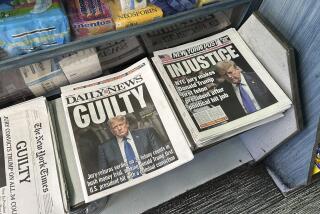Op-Ed: Who’s to blame for fake news?

Social media makes news accessible to its users, but also exposes them to false information.
- Share via
When the problem of fake news first started making headlines, I was traveling across Southeast Asia and the Middle East. That vantage point provided a striking contrast: While we in America waste the right to a free press, half a world away, the right is so precious that people routinely risk their lives to support it.
In nations where media are state run or state approved, journalists who try to work independently are often threatened, arrested and even shot or beheaded. To simply be harassed is a good day. In Turkey since the July coup, for example, the government has detained at least 200 journalists, and, according to Punto 24, a Turkish nonprofit devoted to press freedom, more than 2,300 have been fired. On Nov. 11 in Egypt, four reporters were detained when they tried to cover economic protests. In places like Myanmar, it’s risky to list your profession as “journalist.” I said, instead, I was a lawyer.
Fake news is hardly a new phenomenon... What is new is a propensity for large segments of society to believe things that are clearly untrue.
Without a doubt, the proliferation of fake news in the United States is a problem. But when I hear calls to shut down or block websites or censor what people can read or watch, my 1st Amendment hackles rise. A free press is fundamental to a free society, and curtailing it is an even bigger threat to our way of life than fake news. Besides, banning content won’t solve anything.
Fake news is hardly a new phenomenon. For decades, Americans have had an appetite for fringe stories, from grassy knoll conspiracy theories surrounding the Kennedy assassination to the alien secrets of Area 51 and the baseless notion that 9/11 was an inside job. We sometimes want truth to be stranger than fiction.
What is new is a propensity for large segments of society to believe things that are clearly untrue. Pope Francis wouldn’t and didn’t endorse Donald Trump. An FBI agent involved with Hillary Clinton’s email investigation wasn’t found dead in a murder-suicide. These memes were launched by specious Internet sites as satire or were put out as purposeful misinformation. Their spread could have been halted by a more skeptical public.
But we delude ourselves if we think that this problem originates only with online trolls and heedless consumers in the thrall of the Internet and social media.
Consider one of the bigger fake news stories of this decade — that a low-budget online video making fun of Islam and the prophet Muhammad spontaneously sparked the violent protest at the U.S. facilities in Benghazi, Libya, on Sept. 11, 2012, and led to the deaths of four Americans, including the U.S. ambassador to Libya.
This was the story initially pushed by key members of the Obama administration, including the White House national security advisor, and accepted by much of the mainstream American media. Throughout September 2012, President Obama himself repeatedly cited the “extremely offensive video” made by a “sort of shadowy character” as the cause or proximate cause of the attack — to David Letterman, to Univision’s Jorge Ramos and to Joy Behar of “The View.” We’ve since learned from then-Secretary of State Hillary Clinton’s private email to her daughter, Chelsea, on the night of the attack that Clinton believed the violence was the work of “an al-Qaeda-like group.” It wasn’t a reporter who uncovered that fact but a U.S. congressional committee.
Forcing Facebook to change its newsfeed algorithm or shutting down websites won’t fix fundamental problems like this.
For Americans to pay attention to real news, newsrooms have to supply it. Too often today, newsrooms are like courtrooms. Reporters, editors and anchors cast themselves as prosecutors or defense attorneys, building a case for or against a story line and molding the evidence to fit their argument. (Some even anoint themselves as judge and jury and explicitly render a verdict after that.)
Reporters must ask tough questions and go where the answers, rather than their preconceptions, lead them. Recall that in the run-up to the Iraq war, the New York Times breathlessly reported on Saddam Hussein’s extensive programs to create weapons of mass destruction. After the invasion, many of these claims could not be substantiated.
Real reporting is detective work, trying to get to the bottom of a story or event. That requires skepticism and patience. If a reporter is going to be an advocate, he or she should play devil’s advocate — and do it with every source, on all sides.
Part of the reason fake news is so easy to believe is that fringe stories no longer read or sound all that different from too many of the real stories. Too often, both have little or no sourcing; they lack context and they get disseminated with almost no fact-checking. Sometimes the fake stories look, sound or read better than real ones. And both are chasing the same thing: ratings or online clicks.
There’s a reason our Founding Fathers explicitly guaranteed freedom of the press in the 1st Amendment. It is imperative for a free and healthy society. Just ask the journalists in unfree places who every day risk their lives on its behalf. If we are squandering that freedom, don’t just blame Facebook or Twitter. Blame all of us.
Greta Van Susteren, a lawyer and former anchor of Fox News’ “On the Record,” is working on a book on social media.
Follow the Opinion section on Twitter @latimesopinion and Facebook
MORE FROM OPINION
California’s legislature should use its supermajority power judiciously
The supposed ‘rebirth’ of Watts makes Jordan Downs residents uneasy
With Trump’s victory, the NRA takes aim at public safety
More to Read
A cure for the common opinion
Get thought-provoking perspectives with our weekly newsletter.
You may occasionally receive promotional content from the Los Angeles Times.










